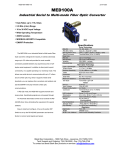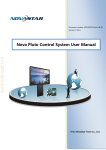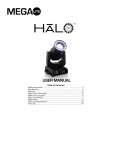Download Black Box Modem Fiber Optic Modem User's Manual
Transcript
MED100A 304 pg. 1 / 4 6132-r1 Model MED100A Fiber Optic Modem Sends RS-232, 422, 485 Signals Up to 2.5 Miles CE Description The MED100A is designed to provide the most versatile connection possible between any asynchronous serial equipment using Fiber Optic cable. It allows any two pieces of asynchronous serial equipment to communicate full or half-duplex over two fibers at typical distances up to 2.5 miles. The converter can also be set up in "Repeater" mode to create a multi-drop master/slave configuration, allowing one serial device to talk to multiple slave devices around a fiber ring. The DIN rail mountable box makes it ideal for industrial cabinets and enclosures. RS-232 data signals up to 115.2K bps and RS-422, or RS-485 data signals up to 460K bps are supported. Different standards can be mixed and matched to allow RS-232 devices to connect to your RS-422 or RS-485 system. This means the MED100A can replace converters and isolators when connecting remote devices, while providing the EMI/RFI and transient immunity of optical fiber. The MED100A supports both the Transmit and Receive data lines, and provides full hardware control of the RS-422/485 driver with automatic Send Data Control circuit. Timeouts are dip-switch selectable between 0.10 and 2.2 ms. All serial connections are provided on terminal blocks, while the multimode fiber is connected via two ST connectors. The unit is powered by 10 to 30VDC at 140 mA max. RS-232 Connections Connection of the MED100A is simple and straightforward. The RS-232 driver and receiver are connected to 2 terminal blocks. The RS-232 DATA OUT is on terminal block (A), and the RS-232 DATA IN is on terminal block (D). Ground is located on terminal block (B) and (C), and power comes in on terminal block (F). RS-422 and RS-485 Connections The RS-422/485 driver and receiver are connected to 4 terminal blocks. Signal ground is on terminal block (M), and power comes in on terminal block (J). When connecting to a four-wire RS-422/485 device or system, connect the output of your device to terminal block (L) (RDB or RD+) and terminal block (K) (RDA or RD+). Connect the input to your device to terminal block (H) (TDB or TD+) and terminal block (G) (TDA or TD-). For two-wire RS-485 systems, the driver and receiver of the MED100A must be connected together by tying terminal blocks (L) and (H) together and (G) and (K) together. This allows the MED100A to communicate half-duplex over the same pair. Refer to Figure 1 for connection diagrams to your RS-422 or RS-485 equipment. If termination is needed, the PCBD is laid out to allow a termination resistor (Rt) to be soldered in across the RD(A) and RD(B) lines. The off-state bias resistor values can also be changed by removing R8 and R16 and replacing them with through-hole components. Figure 1: RS-422/485 Connection Diagrams 422/485 4W Device MED100A FOSTCDR TD A (-) (K) RD A TD B (+) (L) RD B RD A (-) (G) TD A RD B (+) (H) TD B GND (M) 485 2 Wire Device Data A (-) MED100A FOSTCDR (K) RD A (L) RD B (G) TD A Data B (+) GND (H) TD B (M) Black Box Corporation - 1000 Park Drive - Lawrence, PA 15055-1018 Tech Support and Ordering: 724-746-5500 - Fax: 724-746-0746 To contact us about Black Box products or services: [email protected] MED100A 304 pg. 2 / 4 6132-r1 Fiber Optic Connections The MED100A uses a separate LED emitter and photo-detector operating at 820 nm wavelength. Connections to the emitter and detector are on ST type connectors. Most multimode glass fiber size can be used including 50/125 µm, 62.5/125 µm, 100/140 µm, and 200 µm. One fiber is required for each connection between a transmitter and receiver. In a point to point configuration, two fibers are required between the two modems, one for data in each direction. A multi-drop ring configuration requires one fiber between TX and RX around the loop. See Figure 2 for typical point-to-point and multidrop configurations. The most important consideration in planning the fiber optic link is the “power budget” of the fiber modem. This value represents the amount of loss in dB that can be present in the link between the two modems before the units fail to perform properly. This value includes line attenuation as well as connector loss. For the MED100A the typical connector to connector power budget is 12.1 dB. Because 62.5/125 µm cable typically has a line attenuation of 3 dB per Km at 820 nm, the 12.1 dB power budget translates into 2.5 miles. This assumes no extra connectors or splices in the link. Each extra connection would typically add 0.5 dB of loss, reducing the possible distance by 166 m (547 ft.). The actual loss should be measured before assuming distances. Figure 2: Typical Setups Point to Point RS-232 RS-422 or RS-485 Device or System MED100A FOSTCDR SW1:6=OFF SW1:6 = OFF TX RX RX Duplex Multimode Fiber TX MED100A FOSTCDR SW1:6=OFF SW1:6 = OFF RS-232 RS-422 or RS-485 Device or System Multi-Drop Ring Full Duplex RS-232 RS-422 or RS-485 Device or System TX MED100A FOSTCDR SW1:6 = OFF SW1:6=OFF Multimode Fiber RX MASTER SW1:6 = ON MED100A FOSTCDR SW1:6=ON RS-232 RS-422 or RS-485 Device or System RX TX SLAVE SW1:6 = ON The Dip-Switch (SW1) on the MED100A defines the mode of operation when being used for RS-422 or RS485. Positions 1 through 5 on the switch determine the timeout of the RS-485 driver. Because the driver is controlled by hardware, a specific time must be set to tell the hardware how long to wait for data on the fiber side before turning off the RS-422/485 driver. If this time is set too short, the driver could be disabled before transmission is complete, resulting in data corruption. If the time is set too long, the RS-485 device may respond before the RS-422/485 driver in the MED100A is disabled, corrupting this response. We recommend that the timeout be set for approximately one character time or longer. The character times for several different baud rates are selectable on switch positions 1 through 5. If you need a different timeout than what is provided, R10 can be removed and replaced with a different value R9. Table 1 shows different timeout values for the switch positions as well as typical R9 replacement values. MED100A FOSTCDR SW1:6=ON SLAVE MED100A FOSTCDR SW1:6=ON SW1:6 = ON SLAVE Dip-Switch Setup RX TX RX TX RS-232 RS-422 or RS-485 Device or System RS-232 RS-422 or RS-485 Device or System Table 1: RS-485 Timeout Selection Baud Rate Pos. 1 Pos. 2 Pos. 3 Pos. 4 Pos. 5 R9 Time(ms) 1200 ON OFF OFF OFF OFF 820 KΩ 8.20 2400 ON OFF OFF OFF OFF 430 KΩ 4.30 4800 OFF OFF OFF OFF ON Not Used 2.20 9600 OFF OFF OFF ON OFF Not Used 1.30 19.2K OFF OFF ON OFF OFF Not Used 0.56 38.4K OFF ON OFF OFF OFF Not Used 0.27 57.6K ON OFF OFF OFF OFF Not Used 0.22 76.8K ON OFF ON ON OFF Not Used 0.14 115.2K ON ON ON OFF OFF Not Used 0.10 153.6K ON OFF OFF OFF OFF 6.2 KΩ 0.06 230.4K ON OFF OFF OFF OFF 4.3 KΩ 0.04 460.8K ON OFF OFF OFF OFF 2.2 KΩ 0.02 Black Box Corporation - 1000 Park Drive - Lawrence, PA 15055-1018 Tech Support and Ordering: 724-746-5500 - Fax: 724-746-0746 To contact us about Black Box products or services: [email protected] MED100A 304 pg. 3 / 4 6132-r1 Position 6 of SW1 sets the unit in a “Multidrop” mode or a “Point-to-Point” mode. When the MED100A is set in a “Multidrop” mode, data arriving on the Fiber Optic receiver is repeated back out the transmitter. When set in a “Point-toPoint” mode, data arriving at the Fiber optic receiver is not sent back out the Fiber Optic transmitter. Position 6 must be turned “On” when the MED100A is to be used in a multi-drop ring configuration. It must be turned “Off” when the MED100A is to be used as either end of a point-to-point communication line. See Figure 3 for typical system setups using the MED100A in its different modes. Positions 7 and 8 of SW1 determine when the RS-422/485 driver and receiver are enabled. Position 7 controls the driver and Position 8 controls the receiver. For RS-422 operation, set both switches to the “Off” position. For multi-drop RS-485 four-wire systems, position 7 should be “On” and position 8 should be “Off.” This allows the receiver to be enabled all of the time and eliminates some possible timing problems. For RS-485 two-wire systems, both switches should be in the “On” position. This disables the RS-422/485 receiver whenever the driver is enabled, preventing data from being echoed back to the fiber side of the MED100A. Table 2 illustrates the switch settings for typical setups. Table 2: 422/485 Switch Settings RS-485 2-Wire Mode (half duplex) RS-485 4-Wire Mode (full duplex) RS-422 Mode (full duplex) Position 7 TX Enable Position 8 RX Enable ON ON ON OFF OFF OFF Multi-drop Operation A multi-drop configuration is created by forming a ring of MED100As. Each transmitter is tied to the following converter’s receiver, starting at a master node and continuing around to each slave and back to the master. By setting SW1:6 to the “On” position on the slaves, all data sent from the master or preceding slaves is echoed back out the fiber transmitter to the rest of the slaves and eventually back to the master node. Because all data is echoed back, there are special considerations when constructing a multi-drop system. The master will see its own transmitted data. This means that the master device must be full-duplex (RS-232, RS-422, or four-wire RS485) and that it must be capable of ignoring or otherwise accepting its own echoed transmission. Slaves must also be able to accept data from previous slaves in the loop. Specifications/Features Transmission Line: Point-to-Point Transmission: Multi-Drop Transmission: Interfaces: Connectors: Dimensions: Power Supply Connections: Recommended Power Supply: Temperature Rating: Dual multimode optical cable Asynchronous, half or full-duplex Asynchronous, half duplex fiber ring RS-232, RS-422, or RS-485 DB25 female for serial connection, ST connectors for fiber 4.3 x 2.3 x 0.95 in (11 x 5.9 x 2.5 cm) Terminal blocks # PSD100 (12VDC, Input voltage range: 10-30 VDC) -40 to +80°C (-40 to +176°F) All specifications given using 62.5/125µm glass multi-mode fiber. Table 3: Recommended Maximum MED100 in a Fiber Ring Topology Baud Rate RS-232 RS-422/485 Operation Operation 460.8 kbps N/A 2 230.4 kbps N/A 4 115.2 kbps 2 8 57.6 kbps 8 16 38.4 kbps 16 24 19.2 kbps and lower 32 32 Model Number: Description: Type: Application of Council Directive: Standards: MED100A DIN mount Fiber Optic Converter Light industrial ITE equipment 89/336/EEC EN 55022 EN 61000-6-1 EN 61000 (-4-2, -4-3, -4-4, -4-5, -4-6, -4-8, -4-11) Black Box Corporation - 1000 Park Drive - Lawrence, PA 15055-1018 Tech Support and Ordering: 724-746-5500 - Fax: 724-746-0746 To contact us about Black Box products or services: [email protected] MED100A 304 pg. 4 / 4 6132-r1 Table 4: Operating Parameters Parameter Data Rates (RS-232 Operation) Data Rates (RS-422/485 Operation) Power Supply Voltage Power Supply Current Draw Optic Wavelength Fiber TX Launch Power Minimum Required Fiber Rx Power Maximum Receiver Power Coupled Power Budget Fiber Range End to End Delay End to End Delay End to End Skew End to End Skew Maximum Total Fiber Ring Length Delay between Rx & Tx on a fiber ring Min. 0 bps 0 bps 10 VDC Typical 12 VDC Max. Conditions 115.2 kbps 500 kbps 30 VDC 140 mA Full RS-485 Termination 820 nm -17 dBm -13 dBm -10 dBm -25.4 dBm -24 dBm -10 dBm 12.1 dB 2.5 miles 2000 ns 2650 ns 550 ns 1000 ns 900 ns 1100 ns 50 ns 120 ns 5 Miles 52 µs Point-to-Point RS-232 Operation (See Notes 1 & 2) Point-to-Point RS-422/485 Operation (See Notes 1 & 2) Point-to-Point RS-232 Operation (See Note 3) Point-to-Point RS-422/485 Operation (See Note 3) (See Note 1) (See Note 4) Note 1: For the total transmission time over long fibers, the time to transverse the fiber must be considered if delay is an issue. Light takes about 8.05 microseconds to travel over 1 mile of fiber. Note 2: When operating in a ring configuration, each node in addition to the two in the point-to-point specification adds an additional 100 to 200 nanoseconds of delay. Note 3: When operating in a ring configuration, each node in addition to the two in the point-to-point specification adds an additional 50 to 70 nanoseconds of skew. Note 4: When operating in a ring configuration, each serial device must wait at least this minimum time between receiving data from the ring and transmitting back on to it. Figure 4: MED100A Circuit Diagram Black Box Corporation - 1000 Park Drive - Lawrence, PA 15055-1018 Tech Support and Ordering: 724-746-5500 - Fax: 724-746-0746 To contact us about Black Box products or services: [email protected]

















